|
|
|
Sort Order |
|
|
|
Items / Page
|
|
|
|
|
|
|
| Srl | Item |
| 1 |
ID:
171645


|
|
|
|
|
| Summary/Abstract |
The European arms industry is challenged by several adverse “headwinds.” Fragmentation leads to costly duplications and, in conjunction with stagnating budgets and sharply increasing costs, prevents firms from exploiting economies of scale and learning. This is exacerbated by size differentials vis-a-vis the leading US arms manufacturers and competition from emerging producers. As some “headwinds” are self-enforcing, far-reaching industrial and policy responses are required to improve the industry's outlook. As exports may not indefinitely compensate for low domestic demand, there is an economic imperative for further cross-border collaboration and consolidation. Despite various EU policy initiatives, progresses regarding the European Defence Equipment Market and strengthening the European Defence Technological Industrial Base have been relatively slow. It remains to be seen whether the European Defence Fund will be the proclaimed “game-changer,” raising competitiveness of the European arms industry. At the same time, the UK's withdrawal from the EU adds uncertainties.
|
|
|
|
|
|
|
|
|
|
|
|
|
|
|
|
| 2 |
ID:
185479
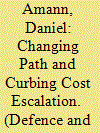

|
|
|
|
|
| Summary/Abstract |
Extant theory suggests that paths of development, although identified as being unsustainable, might be difficult to depart from. The aim of this study has therefore been to explore and understand how a path change can be facilitated in a setting of complex product systems. A unique single case of product development that managed to curb an unsustainable intergenerational cost escalation for complex defence equipment has been studied. The study shows a relation between a path change and a challenging opportunity, and also indicates how this relation can be moderated by the company management and the customers. The study provides both theoretical and practical implications, supporting understanding and facilitation of path changes.
|
|
|
|
|
|
|
|
|
|
|
|
|
|
|
|
| 3 |
ID:
050278
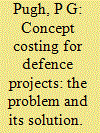

|
|
|
| 4 |
ID:
144156
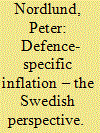

|
|
|
|
|
| Summary/Abstract |
This article uses a Swedish perspective and context to illustrate general, theoretical and applied, discussions on defense-specific inflation, productivity in defense, cost escalation of defense equipment, absolute and relative defense capability plus the construction and use of defense price indices. Sweden uses a Defense Price Index (FPI) which is a composite index of different civilan, non-defense, indices to “automatically” adjust the defense budget for price changes. This should ideally allow decision makers to concentrate on incremental decisions and their economic consequences when deciding on a new defense budget. This approach requires a high precision from FPI in targeting defense inflation. The problems with achieving such a precise index are illustrated in the article. Critical points, in particular, are defining and measuring productivity in defense and price and/or cost escalation of defense equipment. Another complication is that defense, and not only defense equipment, is a “tournament good” where the most important capability is the relative capability compared mainly with potential opponents in military conflicts and not the absolute capability. Since Sweden recently abolished conscription there are reflections on opportunity costs of conscription in the article as well as results from Swedish and other studies on cost escalation of defense equipment.
|
|
|
|
|
|
|
|
|
|
|
|
|
|
|
|
| 5 |
ID:
144152
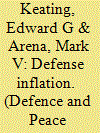

|
|
|
|
|
| Summary/Abstract |
US Department of Defense (DoD) procurement and maintenance costs have risen considerably faster than economy-wide inflation over the last several decades. This outcome has occurred in large part because DoD decision-makers have demanded more complex, better maintained systems over time. Defense inflation is likely to abate when resourcing levels no longer accommodate these demands. Defense inflation should be viewed partially as a symptom, not just as a cause, of increased defense spending.
|
|
|
|
|
|
|
|
|
|
|
|
|
|
|
|
| 6 |
ID:
076427


|
|
|
|
|
| Publication |
2007.
|
| Summary/Abstract |
This paper, intended to stimulate debate, suggests that we are at a turning point in the history of the UK military aerospace industry. It argues that there is urgent need for a fresh vision as to how the UK military aerospace industry can both prosper and make its maximum contribution to the defence of Britain. Further, the resulting plans and policies must emphasise the robustness of defence capabilities in a future in which the only thing we can be certain is that it will be very different from the present - especially whenever defence most matters.
|
|
|
|
|
|
|
|
|
|
|
|
|
|
|
|
| 7 |
ID:
172145
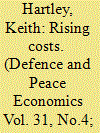

|
|
|
|
|
| Summary/Abstract |
Rising military equipment costs were famously identified by Norman Augustine with forecasts of a single aircraft air force by 2054. This paper presents and analyses an original data set for UK military aircraft. It provides evidence on cost escalation for various UK aircraft types comprising fighter/strike, bombers, military transports, maritime patrol aircraft, helicopters, trainers and civil aircraft. Continued cost escalation is identified for almost all types but with different cost escalation factors. It is concluded that the specific Augustine hypothesis of costs rising by a factor of four every 10 years might be an under-estimate.
|
|
|
|
|
|
|
|
|
|
|
|
|
|
|
|
| 8 |
ID:
144153
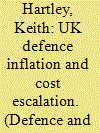

|
|
|
|
|
| Summary/Abstract |
The UK experience with defence inflation and cost escalation is described and analysed. Evidence is presented and policy solutions are reviewed. Optimism bias is a source of cost escalation and this bias is analysed with game theory and public choice models. The key facts remain, namely, that defence inflation exceeds the GDP deflator, and despite various reforms, cost escalation continues.
|
|
|
|
|
|
|
|
|
|
|
|
|
|
|
|
|
|
|
|
|